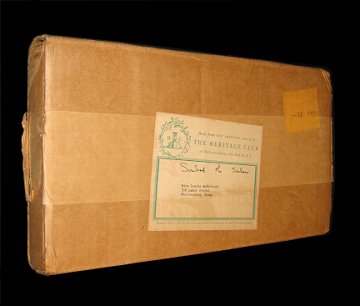

|
My wife's great aunt passed away several months ago, and I had the good fortune to inherit several boxes of books. Some of them were nice in the conventional, profit-producing sense of the word - uncommon and in demand - but others were, though relatively common, remarkable in another sense. You see, sometime in the 1940s the GA subscribed to The Heritage Press. Every month or so, a fresh, new classic wrapped in a glassine dust jacket and housed in a slipcase was delivered to her door. Only she didn't open the boxes - or she slit the packaging tape carefully on one end of the box, presumably slid out the volumes to inspect them, and slid them right back in, never to touch them again. For the next 60 years or so, they were stored upstairs in her ca. 1880s Victorian house. Those of you who have experience with HP books know only too well that once you place any HP volume on a shelf, two things commence. First, backstrip fading. For some inexplicable reason, George Macy cut corners on board-cloth dyes - they weren't color-fast to any helpful extent - and it seems that no matter what sort of room these books are stored in, if there's any light at all, some degree of color degradation occurs over time. You can readily evaluate the damage by sliding a copy out of a slipcase and comparing the bright colors on the boards with the faded ones on the backstrip. The slipcase is also subject to fading, but that's not all: Because it's covered in paper, the slightest bump is likely to damage it. So - what does this mean for HP collectors? Inevitably, compromise. There will never be opportunities to acquire truly fine copies of any of the titles. Or will there? Well, unlikely as it seems, I am now in possession of a small collection that features 60-year-old HP copies in AS NEW condition. Check out Sinbad the Sailor:

HP collectors will certainly be interested in this, no? But how interested? Are you thinking what I'm thinking? Yes, it's high time to conduct an experiment. Sometime in the next month or two, BookThink will auction one of these copies on eBay and see what happens. To eliminate the possibility of any tampering, I'll report back to you shortly after the auction closes and supply the item number so you are free to inspect things. Should be fun, and perhaps will gain some insight into how much importance HP collectors place on condition. Meanwhile, if you'd like to refresh your memory on buying and selling HP titles, here are two pertinent BookThink articles: "Buying and Selling the Heritage Press" "A Heritage Press retrospective: How These Books Came To Be" Ok, onto what's happening today. I'm especially pleased to announce that longtime bookseller and author of the 2008 First Edition Price Guide Thomas Lee is launching a BookThink column. Each month Tom will showcase specific collectible titles, often those that present significant edition state identification difficulties, and include a detailed discussion that should clear the air once and for all and enable you to spot firsts with the best of them. Today, there will be some general discussion of first edition identification followed by a close look at a title all of us run into from time to time - Dan Brown's The Da Vinci Code. If you don't yet own a copy of Tom's guide, BookThink is the cheapest place to buy it new. Also, Jill Hendrix returns today with another installment in her series, “How to Start a Clicks-and-Bricks” used bookstore. This time she explains the options we have for choosing a business structure. Those of you who haven't visited BookThink's links page recently should take a look. New links and in some cases categories are added by BookThink's Links Editor Judy Lanskey every month. Of special note is a new category on first edition identification.
< to previous article
to next article >
Questions or comments?
| Forum
| Store
| Publications
| BookLinks
| BookSearch
| BookTopics
| Archives
| Advertise
| AboutUs
| ContactUs
| Search Site
| Site Map
| Google Site Map
Store - Specials
| BookHunt
| BookShelf
| Gold Edition & BookThink's Quarterly Market Report
| DomainsForSale
| BookThinker newsletter - free
Copyright 2003-2011 by BookThink LLC
|

|
|